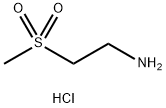2-Aminoethylmethylsulfone hydrochloride

|
- ₹6700
- Product name: 2-Aminoethylmethylsulfone hydrochloride
- CAS: 104458-24-4
- MF: C3H10ClNO2S
- MW: 159.63
- EINECS:1806241-263-5
- MDL Number:MFCD03840162
- Synonyms:2-MESYLETHAN-1-AMINE HYDROCHLORIDE;2-(Methylsulfonyl)-ethanamine hydrochloride;2-(methylsulfonyl)ethylamine hydrochloride;2-Aminoethylmethylsulfone hydrochloride;2-(METHANE SULFONYL)ETHYLAMINE HYDROCHLORIDE;2-(Methylsulfonyl)ethanamine hydrochloride ,95%;Lapatinib Intermediate 1;2-(Methylsulfonyl)ethanaMine hydrogen chloride
1 prices
Selected condition:
Brand
- TCI Chemicals (India)
Package
- 5G
- ManufacturerTCI Chemicals (India)
- Product numberA2464
- Product description2-Aminoethyl Methyl Sulfone Hydrochloride
- Packaging5G
- Price₹6700
- Updated2022-05-26
- Buy
| Manufacturer | Product number | Product description | Packaging | Price | Updated | Buy |
|---|---|---|---|---|---|---|
| TCI Chemicals (India) | A2464 | 2-Aminoethyl Methyl Sulfone Hydrochloride | 5G | ₹6700 | 2022-05-26 | Buy |
Properties
Melting point :168.0 to 172.0 °C
storage temp. :Inert atmosphere,Room Temperature
solubility :DMSO (Slightly, Sonicated), Methanol (Slightly, Sonicated)
form :Solid
color :White to Off-White
Stability :Hygroscopic
InChIKey :AMYYUKGKCJKCBI-UHFFFAOYSA-N
CAS DataBase Reference :104458-24-4(CAS DataBase Reference)
storage temp. :Inert atmosphere,Room Temperature
solubility :DMSO (Slightly, Sonicated), Methanol (Slightly, Sonicated)
form :Solid
color :White to Off-White
Stability :Hygroscopic
InChIKey :AMYYUKGKCJKCBI-UHFFFAOYSA-N
CAS DataBase Reference :104458-24-4(CAS DataBase Reference)
Safety Information
| Symbol(GHS): |

|
|||||||||||||||||||||
|---|---|---|---|---|---|---|---|---|---|---|---|---|---|---|---|---|---|---|---|---|---|---|
| Signal word: | Warning | |||||||||||||||||||||
| Hazard statements: |
|
|||||||||||||||||||||
| Precautionary statements: |
|
Description
Lapatinib is a new drug targeted for the treatment of breast cancer developed by GlaxoSmithKline, which was approved for marketing by the US Food and Drug Administration on March 13, 2007. The currently approved indications are advanced mastocarcinoma treated with lapatinib and capecitabine or metastatic breast cancer, and breast cancer patients must be treated first in other first-class drugs. Its trade name is Tykerb in the United States. On December 14, 2007, the European Medicines Agency (EMEA) approved for marketing of lapatinib in Europe, and the trade name is Tyverb. Breast cancer molecular targeted therapy is the treatment for oncogene related with occurrence and development of breast cancer, and for its related expression product. Molecular targeted drugs control the changes of gene expression in the cell through blocking signal transduction of tumor cell or related cell, thereby inhibiting or killing tumor cells.Lapatinib is a small molecule epidermal growth factor tyrosine kinase inhibitor orally. Clinical trials have shown that lapatinib has a very good clinical effect in patients with HER2 breast cancer who have been resistant to Roche's Herceptin. In vitro, the inhibitory effect of lapatinib on the growth of Her-2 overexpressing breast cancer cell lines was significant. Lapatinib is also highly effective in the Phase I clinical trial of Her-2 overexpression in advanced breast cancer and has no cross-resistance with Herceptin (trastuzumab). Unlike Herceptin (trastuzumab), its structure is small molecules, so it could get through the blood-brain barrier, thereby having a certain therapeutic effect for breast cancer brain metastases.
Related product price
- 2-Phenylethylamine hydrochloride
₹8432.68-18608.18 - Diethylamine hydrochloride
₹1089-46960 - Ethylamine hydrochloride
₹2000-9830






